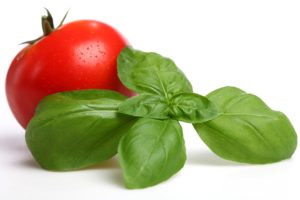Basil with tomato, basil with garlic, basil with onion, and basil with olives.
The sweet, clove-like aroma and warm and peppery yet minty flavor of basil can liven up mixed green salads, vegetables and vegetable soups, pasta and pizza, eggs dishes and eggplant salad, fish and seafood, veal, lamb, pork, and chicken.
Basil—which is native to India–is a key herb in the Mediterranean regional cooking of France and Italy and is important to Thai, Vietnamese, and Laotian cookery as well.
Sweet basil—like other basils—is available from the garden in summer; hothouse basil can be found year-round. Hothouse basil can be tenderer than garden-grown basil but less aromatic.
Serving sweet basil
Sweet basil is the definitive herb for tomatoes. To a salad of firm ripe tomatoes that have been cored and peeled, add ½ cup vinaigrette, 1 tablespoon chopped Italian parsley, and 1 tablespoon chopped fresh sweet basil.
- To liven up any fresh green salad, add fresh chopped sweet basil leaves or whole tiny basil leaves.
- For a summery pesto, blend 2 cups of loosely packed fresh sweet basil leaves with ½ cup light olive oil, 2 tablespoons toasted pine nuts, 4 large minced garlic cloves, and 1 teaspoon coarse salt. Afterward, stir in ½ cup of freshly grated Parmesan cheese, 2 tablespoons freshly grated Romano cheese, and 2 tablespoons of softened unsalted butter.
Favorite basil recipes
How to Make Classic Basil Pesto
Other basils
There are more than 60 varieties of basil in various shades of green, reddish, and purple. Sweet basil—also called Genoese basil, with large, bright green, silky leaves–is most often used for cooking in the Western world.
Here are other basils also used in the kitchen:
- Purple basil—which is often called opal basil—has purple to purple-black leaves and is often used to add color to green salads and is especially good with rice dishes.
- Lemon basil has bright, yellowish-green leaves and is used to add a lemon scent and flavor to dishes.
- ‘Green Ruffles’ basil is larger than sweet basil and is spicier and aniseed-flavored and is used in salads and stir-fries.
- Cinnamon basil has olive-brown-green leaves, is cinnamon-scented when rubbed, and is used in spicy dishes and salad dressings.
- Greek basil has small leaves and can be added unchopped to salads and tomato sauces.

How to choose basil
Select fresh, aromatic basil. Avoid basil that is wilted, slimy, or has dark spots. Young basil is the best flavored. Basil becomes bitter after flowering.
How to store basil
Basil that has been washed and dried will keep for 3 to 4 days wrapped in a damp paper towel and placed in a plastic bag in the refrigerator. You can also trim the stems and stand basil in water covering the base of the stems and keep it for 2 or 3 days making sure to change the water daily.
Serving basil
Use basil fresh or dried to add a mild, sweet flavor to soups, salads, stews, fish, meat, sauces, and eggs. Use basil fresh with ripe tomatoes adding a little oil and lemon juice.
- Use lemon basil to add a sharp, spicy, lemon flavor to cooked fish.
- Toss cooked pasta or rice in heated olive oil to which turn purple basil has been added.
- Combine sweet basil with crushed garlic, bread crumbs, chopped nuts, lemon peel and beaten egg to make stuffing for chicken.
Tear basil with your fingers rather than chop.
Basil flavor partners
Basil has a flavor affinity for carrot, chicken, corn, cream cheese, eggplant, eggs, fish, garlic, goat cheese, lemon, mozzarella, olives, olive oil, pasta, peas, pizza, potatoes, rice, tomato, veal, white beans, and zucchini.
Basil combines well with capers, chives, cilantro, garlic, marjoram, oregano, mint, parsley, rosemary, and thyme.
About basil
Sweet basil is a warm-season annual that grows upright from 12 to 24 inches (30-60 cm) tall and almost as wide. Basil leaves are shiny and succulent, toothed, and pointed oval.
While sweet basil is native to India, there are other basils that are native to the Middle East, Africa, Central America, and the Pacific Islands.
The name basil is said to be an abbreviation of Basilikon photon which is Greek for “kingly herb.”
The botanical name for sweet basil is Ocimum basilicum. The botanical name for purple basil is O. b. var. purpurascens; for lemon basil O. x citriodorum; for Greek basil O. minimum ‘Greek’.
Articles of interest:
Best Herbs for Container Growing
Garden Planning Books at Amazon:
- Vegetable Garden Almanac & Planner
- Kitchen Garden Grower’s Guide Vegetable Encyclopedia
- Vegetable Garden Grower’s Guide
- Tomato Grower’s Answer Book
More kitchen tips:
Bring your harvest to the table. Kitchen prep tips and easy recipes for the vegetables you grow. Click below for vegetable prep and recipes you can use now.
- Almonds
- Apples
- Apricot
- Aprium
- Artichoke
- Arugula
- Asparagus
- Avocado
- Bamboo Shoots
- Banana
- Basil
- Beans, Dried
- Beans. Long
- Beans, Shell
- Beans, Snap
- Beets
- Bitter Melon
- Blackberry
- Bok Choy
- Broccoli
- Broccoli Raab
- Brussels Sprouts
- Cabbage
- Cardoon
- Carrots
- Cauliflower
- Celeriac
- Celery
- Chard
- Chayote Squash
- Cherimoya
- Cherries
- Chestnut
- Chickpea
- Chinese Cabbage
- Chives
- Cilantro
- Citron
- Clementine
- Collards
- Coriander
- Corn, Sweet
- Corn, Baby
- Corn Salad, Mache
- Cranberry
- Cress
- Cucumber
- Daikon
- Dandelion
- Dill
- Eggplant
- Endive, Belgian
- Endive and Escarole
- Fava Beans
- Fig
- Florence Fennel
- Garlic
- Ginger
- Grapefruit
- Grapes
- Guava
- Horseradish
- Jerusalem Artichoke
- Jicama
- Jujube
- Kale
- Kiwifruit
- Kohlrabi
- Kumquat
- Leeks
- Lemongrass
- Lemons
- Lettuce
- Lime
- Mache (Corn Salad)
- Mandarin Orange
- Mango
- Maple Syrup
- Marjoram
- Melons
- Michihili
- Mint
- Mizuna
- Mushrooms
- Mushrooms, Cremini
- Mustard Greens
- Napa Cabbage
- Nectarine
- Okra
- Olives
- Olive oil
- Onions
- Oranges
- Oregano
- Parsley
- Parsley Root
- Parsnips
- Passion Fruit
- Pawpaw
- Peaches
- Pears
- Peas, Garden Snap
- Peas, Snow
- Pei Tsai
- Peppers, Chili
- Peppers, Sweet
- Persimmon
- Pineapple
- Pineapple Guava
- Plantain
- Plums
- Pluots
- Pomegranate
- Potatoes
- Prickly Pear
- Pumpkin
- Quince
- Radicchio
- Radishes
- Raspberries
- Rosemary
- Rhubarb
- Rutabaga
- Sage
- Salsify
- Sauerkraut
- Savory
- Shallots
- Sorrel
- Spinach
- Squash, Summer
- Squash, Winter
- Strawberries
- Sunchokes
- Sunflower
- Sweet Potato
- Swiss Chard
- Tangerine
- Taro
- Tarragon
- Thyme
- Tomatillo
- Tomato
- Turnip
- Turnip Greens
- Yams















